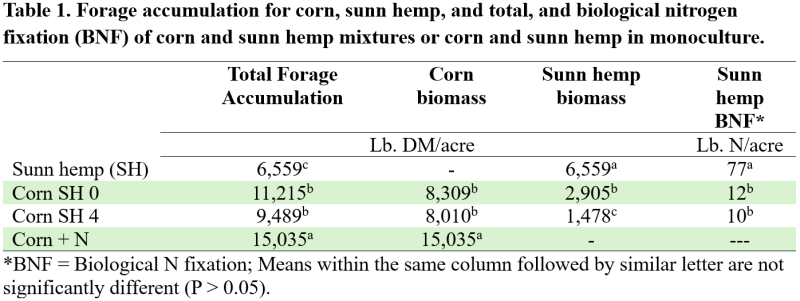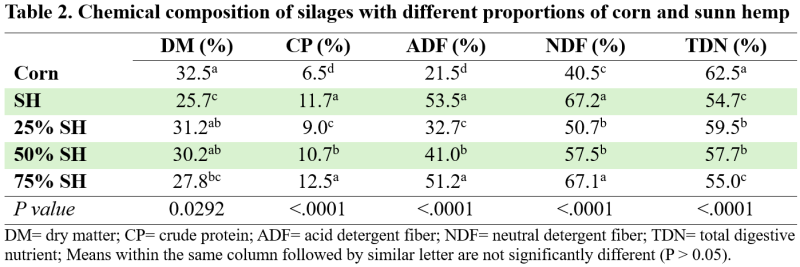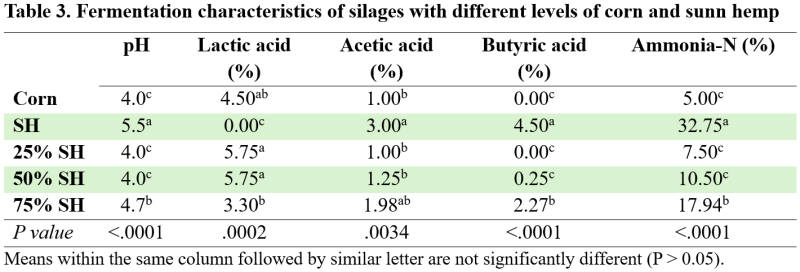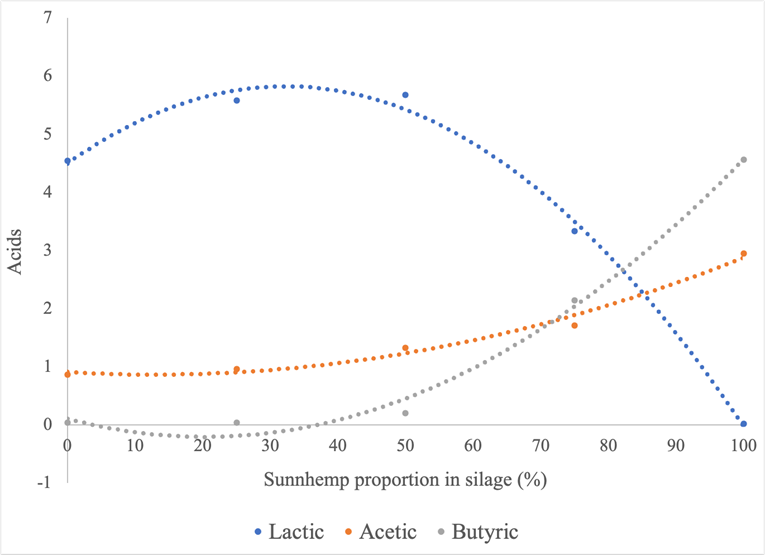Flavia F. Simili, Jose Dubeux, Igor L. Bretas, Luana M. D. Queiroz, Mario A. Lira Junior, Beatriz E. B. Cremostim, Rafael S. Reis, Javier P. Acuna, Kevin R. Trumpp, Kenneth Oduor, and Marilia A. Bernardini, North Florida Research and Education Center, Marianna
Introduction
Corn silage is a commonly used roughage source in livestock systems around the world, particularly for dairy production. In 2022, the United States produced approximately 129 million tons of corn silage, obtained from 6.9 million acres of land. Using corn silage as ruminant feed offers several benefits, including high energy content, good palatability, high forage productivity, the ability to maintain forage quality as a crop matures, and flexibility of use. However, a high protein supplement is needed when feeding corn silage, since corn silage has low to moderate protein levels. Adding legumes during the ensiling process can be an effective way to improve the protein concentration of corn silage. It is also an opportunity to reduce nitrogen (N) fertilizer costs, because legumes like sunn hemp have the ability to fix atmospheric nitrogen. Planting sunn hemp (SH) and corn in alternate rows could be a possible way to produce silage with lower N-fertilizer input. In this article, we present a summary of a trial conducted at the the UF/IFAS North Florida Research and Education Center (NFREC)-Marianna on corn-sunn hemp blends for silage production.
–
Sunn Hemp Mixed with Corn Can be Used for Silage
Sunn hemp, which is a valuable legume known for its high crude protein concentration and N fixation capability, can be particularly helpful in producing silages of superior nutritive value. Furthermore, intercropping sunn hemp and corn is a great way to reduce the amount of nitrogen fertilizer required. In fact, this is especially beneficial because corn crops require high rates of nitrogen fertilizer application, which can be expensive and also leach into ground water. Sunn hemp is a fast-growing green manure crop grown in tropical regions. This annual legume has been used in Florida in crop rotations because of its potential to mitigate soil nematode infestation, being a better option for summer rotation to reduce sting nematode. Summer rotation with sunn hemp also leads to improved spring silage corn yield and winter rye growth (Tsegay et al., 2024).
Sunn hemp has a high nutritive value, as high as 18% crude protein and 55% in vitro digestible organic matter. However, sunn hemp often has a high moisture content at harvest, which affects silage fermentation characteristics which can decrease forage quality. Legumes are also known to buffer pH during fermentation, which makes silage conservation a challenge during ensiling. Thus, it is important to know the proportion of sunn hemp that should be added to corn to produce high-quality silage. At NFREC Marianna, we conducted tests to analyze how different ratios of sunn hemp mixed with corn would affect the biomass accumulation and chemical composition of the silage.
For comparison in the field, we established pure stands of sunn hemp, corn, and mixed stands of sunn hemp and corn planted either the same date (Corn+SH 0) or planting corn first and sunn hemp 4 weeks later (Corn+SH 4). Corn, sunn hemp, and corn + sun hemp planted at the same date were seeded on 3/22/2023. For the plots with corn planted first and sunn hemp 4 weeks later, the sunn hemp was planted 4/19/2023. The corn monoculture received 200 lbs. N/acre, while corn-sunn hemp mixtures received 44.5 lbs. N/acre, with P and K applied following soil test recommendations. Corn was planted at 32,000 seeds/acre and sunn hemp at 15 lbs./acre, with 36” rows. When corn and sunn hemp were planted together, we had alternate rows of corn and sunn hemp (Figure 1A). Plots were harvested 7/5/2023. Corn receiving full N application (200 lbs. N/acre) produced more biomass than other treatments, but sunn hemp and corn planted at the same date produced 75% of corn monoculture but received only 22% of the N fertilizer (Table 1). Sunn hemp when planted in monoculture added 77 lbs. N/acre via biological N fixation (Table 1). The N contribution was reduced when planted in mixture with corn.
After harvesting, the forages were ensiled using different proportions of corn and sunn hemp. More specifically, we investigated the replacement of corn by sunn hemp (25%, 50%, and 75%, compared to 100% corn silage, and 100% sunn hemp silage) and how it impacted silage composition (Figure 1A and B). We used “mini silos” to assess the silage fermentation characteristics and their chemical composition.
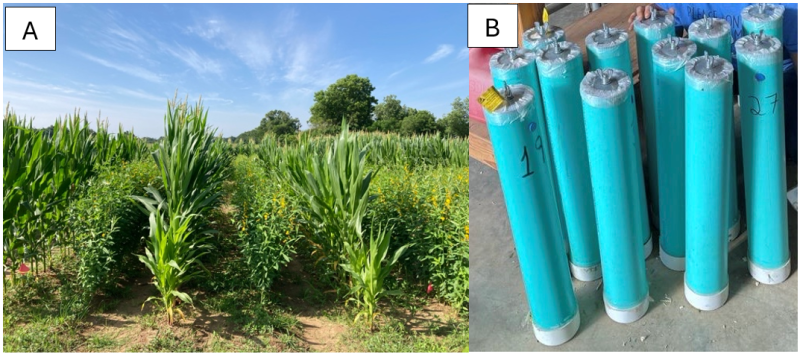
Figure 1 – Intercropping corn with sunn hemp in the field at UF IFAS NFREC Marianna (A) and mini silos (B). Photo credit: Flavia Simili, UF/IFAS
–
When corn silage was mixed with 25% and 50% of sunn hemp (SH), there was an improvement in the crude protein (CP) concentration of the silage (Table 2) compared to 100% corn silage. However, the dry matter (DM) concentration of the mixture remained similar. On the other hand, when 100% SH and 75% SH were used, the dry matter concentration was less than 30%. This indicates that these silages had a higher moisture concentration, which could compromise the silage fermentation process (Table 3). Our results showed that SH silage had a greater fiber concentration in comparison with corn silage (ADF and NDF), which can make the ensiling process more difficult and decrease the total digestive nutrients (TDN) percentage (Table 2). These findings suggest that mixing SH with corn can enhance the nutritional value of the silage, but the proportion of SH should be maintained at an optimal level to avoid any reduction in quality.
It was observed that when the sunn hemp percentage was increased to more than 50% of the silage, the fermentation characteristics started to become undesirable (Table 3). The ideal silage pH should range between 3.7 and 4.0. However, legume silages tend to maintain a higher pH, between 4.3 and 5.0. The low pH is important for stabilizing the fermentation process of silage by preventing the growth of microbes that cannot tolerate low pH levels. Besides, well-fermented silages should have lactic acid between 3 to 6% and not contain detectable levels of butyric acid. The presence of butyric acid indicates metabolic activity from clostridial organisms, which results in significant dry matter losses and poor recovery. Likewise, ammonia nitrogen (Ammonia-N) levels below 10-15% indicate good fermentation, while higher values suggest proteolytic activity from clostridia. According to our results, fermentation conditions were best when we mixed 25% SH, which was similar to corn silage. However, when we included 50% SH, butyric acid detectable levels were observed (Table 3 and Figure 3). If sunn hemp is the only material to make the silage, propionic acid should be used at 1% inclusion level based on the study performed at RCREC.

Figure 2. Mixing sunn hemp (SH) with corn (A); Samples of silage with 60-d fermentation inside mini silos (B); T1= corn silage; T2= SH silage; T3= 25% SH; T4= 50% SH; T5= 75% SH.
–
These results (Figure 3) suggest that the optimal concentration of sunn hemp for well-fermented silages mixed with corn was between 30% and 40%. Above these proportions, fermentation characteristics were affected.
–
Take Home Message
Including sunn hemp in corn silage is a great option to increase crude protein to reduce the need for animal protein supplementation. Furthermore, sunn hemp grows its own nitrogen and is an important crop to use in rotations to mitigate sting nematodes. Growing sunn hemp and corn together reduces the amount of N fertilizer needed to produce silage. Mixing 30 to 40% sunn hemp with corn results in a well-fermented silage with reduced protein supplementation for feeding. So, one solution might be to plant sunn hem in every third row instead of alternating the two crops. Further research is warranted to assess animal intake and performance when feeding corn-sunn hemp silage.
–
References
Tsegay, M.W., M.O. Wallau, C. Liu, J.C.B. Dubeux, Jr., Z.J. Grabau. 2024. Crop rotation for management of plant-parasitic nematodes in forage corn production. Agronomy Journal, 116:313-325.
- 2025 UF/IFAS Forage Legume Conference – May 1 - March 28, 2025
- How are My Cool-season Forages Recovering from the Snowfall and Low Temperatures? - January 31, 2025
- Integrated Crop-Livestock Systems Improve Soil Health - July 26, 2024

